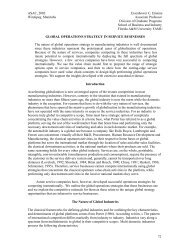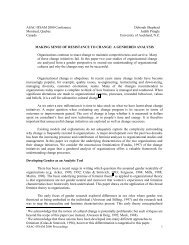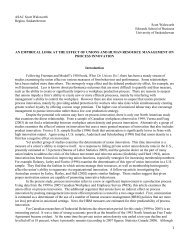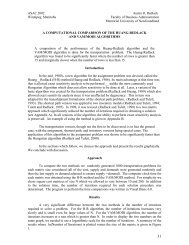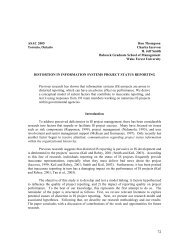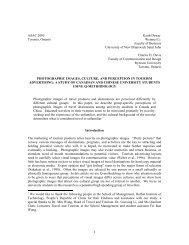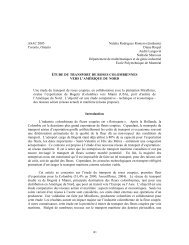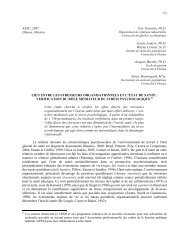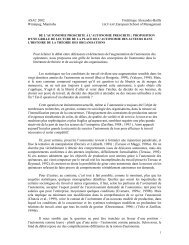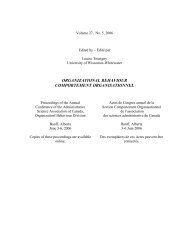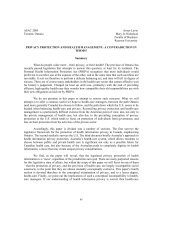Organizational Behaviour Comportement Organisationnel
Organizational Behaviour Comportement Organisationnel
Organizational Behaviour Comportement Organisationnel
Create successful ePaper yourself
Turn your PDF publications into a flip-book with our unique Google optimized e-Paper software.
Task-Gender (male-stereotyped or female-stereotyped), Judge Gender (male or female). Thiswas crossed with a 2 x 2 between-subjects factorial design involving: Order (the order in whichthe group discussed the two gender-oriented cases), Assistant gender (male or female), which wasintended to control for potential confounding effects. This design was crossed with a 2 x 3between-subjects factorial design involving: Gender of the participant (male or female),Numerical Status (proportional representation in the group based on gender - numerical minority,balanced or majority status). The covariates assessed in this study were intended to control forpossible confounds and included: the relational demography score of the participant; theparticipant’s age in years; whether the participant had previous familiarity with other groupmembers; the participant’s self-efficacy in communication; and the participant’s masculinity andfemininity scores. Table 2 reports a summary of the descriptive statistics of all variables in thisstudy.________________________Insert Table 2 about here________________________For the purpose of data analyses, interruption behavior was measured by correcting thenumber of interruptions made by a participant for the time the participant spoke (Kollock, Blumstein& Schwartz, 1985). Consistent with methods previously employed (e.g., Smith-Lovin & Brody,1989), the correction was obtained by using the logarithm ratio of the number of interruptions madeby the participant to the total time for which the participant spoke. Total talking time (recorded inminutes and seconds) was obtained for every participant in each of the 72 group discussions byindependent research assistants. In the male-stereotyped task, talking times ranged from 0.00seconds to 16 minutes, 23 seconds (M = 4 minutes 28 seconds, SD = 3 minutes 24 seconds). Inthe female-stereotyped task, talking times ranged from 5 seconds to 19 minutes 50 seconds (M =4 minutes 30 seconds, SD = 4 minutes 4 seconds). Levels of inter-rater reliability in both themale-stereotyped and female-stereotyped task were adequate, as reflected in the intra-classcorrelations between male and female judges on our measure of interruptions (male-stereotypedtask (r I = 0.83), female-stereotyped task (r I = 0.81).One essential aim of our analyses was to examine the effects of a member’s gender andthe member’s proportional representation on interruption behavior. Hypothesis 1 predicted thatproportional representation will have different consequences for men versus women. Thisassertion was tested by examining the two-way interaction of Gender and Numerical Status.There was a significant interaction effect between these two-factors (F(2, 174) = 4.66, p < .05. η 2= 0.05). As indicated in Table 3, the results support the assertion of Hypothesis 1 - men in thenumerical majority position differed significantly from women in majority positions with regardto the level of interruptions exhibited (t(174) = 2.43, p < .05, d = 0.35). Specifically, majoritymales interrupted significantly more (M = 1.39, SE = 0.08) compared to females (M = 1.11, SE =0.08).Further examination of the significant Gender x Numerical status interaction can be madewith respect to the predictions of Hypothesis 2 and 3 which consider a within-gender comparisonamong members who are represented in different proportional representations – majority,balanced or minority positions. Hypothesis 2 asserted that men in numerical majority positionswill exhibit higher levels of interruption behavior compared to their same-gender counterparts innumerically balanced and minority positions. This assertion is supported by the pattern of meansevident in Table 3. As indicated by the direction of the changes in the reported means,interruption behavior increases among male group members as one moves from numericalminority positions, to balanced positions, to numerical majority positions.Hypothesis 3 predicted that women in numerical majority positions will exhibit lower8



